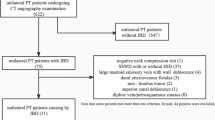Abstract
Introduction
Tinnitus is a common symptom in which etiology is unclear in a group of patients. Some of anatomic or vascular variations diagnosed on temporal bone computed tomography (CT) has been known to cause tinnitus particulary pulsatile form. Therefore significance of these anatomic variations has not been validated in patients with nonpulsatile tinnitus. The aim of this study is to ascertain several anatomic variations previously attributed to pulsatile tinnitus in nonpulsatile tinnitus patients. And secondly to assess the relationship between the amount of sigmoid sinus bulging and mastoid emissary vein (MEV), enlargement of those was not evaluated before in tinnitus patients.
Methods
Retrospectively, temporal bone CT scans of 70 patients with an existing complaint of tinnitus with unexplained etiology were enrolled. As a control group, 70 patients were selected from paranasal sinus CT scans without any otological or clinical findings.
Results
The type of tinnitus was subjective and nonpulsatile in the overall group. The diameters of enlarged MEV on the left side were significantly higher in the tinnitus group. Carotid canal dehiscence and high riding jugular bulb were significantly higher in the tinnitus patients. Petrous bone pneumatization was significantly lower in the tinnitus patients than in the control group.
Conclusions
In patients who complained of subjective nonpulsatile tinnitus with unknown etiology, some temporal bone vascular variations, including high riding jugular bulb, dehiscent carotid canal, left-sided MEV enlargement, and petrous bone pneumatization, seemed to have an association with tinnitus. Further studies comparing all these entities between pulsatile and nonpulsatile groups and healthy controls should be undertaken.




Similar content being viewed by others
References
Davis A, El Rafaie A (2000) Epidemiology of tinnitus. In: Tyler RS (ed) Tinnitus hand book. Singular, Thompson Learning, San Diego, pp 1–23
Baguley D, McFerran D, Hall D (2013) Tinnitus. Lancet 382(9904):1600–1607
Nondahl DM, Cruickshanks KJ, Huang G-H et al (2011) Tinnitus and its risk factors in the Beaver Dam offspring study. Int J Audiol 50:313–320
Madani G, Connor SE (2009) Imaging in pulsatile tinnitus. Clin Radiol 64:319–328
Zhao P, Lv H, Dong C, Niu Y, Xian J, Wang Z (2016) CT evaluation of sigmoid plate dehiscence causing pulsatile tinnitus. Eur Radiol 26(1):9–14
Grewal AK, Kim HY, Comstock RH, Berkowitz F, Kim HJ, Jay AK (2014) Clinical presentation and imaging findings in patients with pulsatile tinnitus and sigmoid sinus diverticulum/dehiscence. Otol Neurotol 35(1):16–21
Zhaohui L, Cheng D, Xiao W, Xiaoyi H, Pengfei Z, Han L, Qing L, Zhenchang W (2015) Association between idiopathic intracranial hypertension and sigmoid sinus dehiscence/diverticulum with pulsatile tinnitus: a retrospective imaging study. Neuroradiology (Epub ahead of print)
Sözen E, Çelebi I, Uçal YO, Coşkun BU (2013) Is there a relationship between subjective pulsatile tinnitus and petrous bone pneumatization? J Craniofac Surg 24(2):461–463
Schuknecht HR (1993) Pathology of the ear, 2nd edn. Lea and Febiger, Philadelphia
Chauhan NS, Sharma YP, Bhagra T, Sud B (2011) Persistence of multiple emissary veins of posterior fossa with unusual origin of left petrosquamosal sinus from mastoid emissary. Surg Radiol Anat 33(9):827–831
Forte V, Turner A, Liu P (1989) Objective tinnitus associated with abnormal mastoid emissary vein. J Otolaryngol 18:232–235
Lambert PR, Cantrell RW (1986) Objective tinnitus in association with an abnormal posterior condylar emissary vein. Am J Otol 7:204–207
Lee SH, Kim SS, Sung KY, Nam EC (2013) Pulsatile tinnitus caused by a dilated mastoid emissary vein. J Korean Med Sci 28(4):628–630
Lo WWM, Solti-Bohman LG, McElveen JT (1985) Aberrant carotid artery: radiologic diagnosis with emphasis on high-resolution computed tomography. RadioGraphics 5:985–993
Dietz RR, Davis WL, Harnsberger HR, JacobsJM Blatter DD (1994) MR imaging and MR angiography in the evaluation of pulsatile tinnitus. Am J Neuroradiol 15:879–889
Eisenman DJ (2011) Sinus wall reconstruction for sigmoid sinus diverticulum and dehiscence: a standardized surgical procedure for a range of radiographic findings. Otol Neurotol 32(7):1116–1119
Pekçevik Y, Pekçevik R (2014) Why should we report posterior fossa emissary veins? Diagn Interv Radiol 20(1):78–81
Krishnan A, Mattox DE, Fountain AJ et al (2006) CT arteriography and venography in pulsatile tinnitus: preliminary results. AJNR Am J Neuroradiol 27:1635–1683
Remley KB, Coit WE, Harnsberger HR et al (1990) Pulsatile tinnitus and the vascular tympanic membrane: CT, MR, and angiographic findings. Radiology 174:383–389
Sonmez G, Basekim CC, Ozturk E et al (2007) Imaging of pulsatile tinnitus: a review of 74 patients. Clin Imaging 31:102–108
Henriksen SD, KindtMW Pedersen CB et al (2000) Pseudoaneurysm of lateral internal carotid artery in the middle ear. Int J Pediatr Otorhinolaryngol 52(2):163–167
Jen A, Sanelli PC, Banthia V et al (2004) Relationship of petrous temporal bone pneumatization to the eustachian tube lumen. Laryngoscope 114(4):656–660
Virapongse C, Sarwar M, Bhimani S et al (1985) Computed tomography of temporal bone pneumatization: 1. Normal pattern and morphology. Am J Roentgenol 145(3):473–481
Schoeff S, Nicholas B, Mukherjee S, Kesser BW (2014) Imaging prevalence of sigmoid sinus dehiscence among patients with and without pulsatile tinnitus. Otolaryngol Head Neck Surg 150(5):841–846
Gologorsky Y, Meyer SA, Post AF, Winn HR, Patel AB, Bederson JBD (2009) Novel surgical treatment of a transverse-sigmoid sinus aneurysm presenting as pulsatile tinnitus: technical case report. Neurosurgery 64(2):E393–E394 (discussion E394)
Acknowledgments
The article is not supported by any organizations.
Author information
Authors and Affiliations
Corresponding author
Rights and permissions
About this article
Cite this article
Kizildag, B., Bilal, N., Yurttutan, N. et al. The relationship between tinnitus and vascular anomalies on temporal bone CT scan: a retrospective case control study. Surg Radiol Anat 38, 835–841 (2016). https://doi.org/10.1007/s00276-016-1629-6
Received:
Accepted:
Published:
Issue Date:
DOI: https://doi.org/10.1007/s00276-016-1629-6




